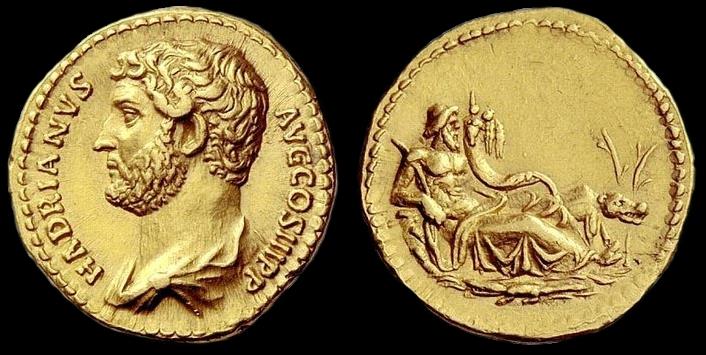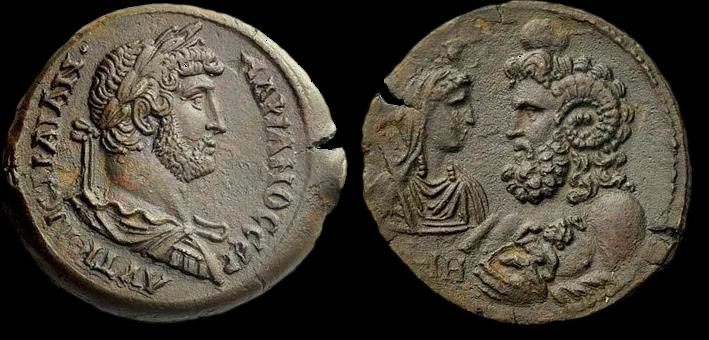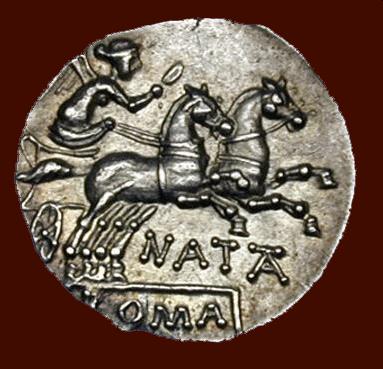




Designed by Nigel G Wilcox


The Paragon Of Metal Detecting
& Archaeology
& Archaeology
Powered By Sispro1
Roman Denarius A.D. - Currency Numismatics,
For Reference ONLY
Everything For The Detectorist
Hadrian 117-138 AD
Roman Timeline
Roman Menu
Copyright © All Rights Reserved by Nigel G Wilcox · · E-Mail: ngwilcox100@gmail.com
| 1. Estimated Value 2022 £ |
1.
1. Roman Gold Aureus of Hadrian (117-138 C.E.), With a Magnificent Anepigraphic Reverse, From the Emperor's 'Travel Series' of Coins
Hadrian 117 – 138
Aureus 134-138, AV 7.36 g. HADRIANVS – AVG COS III P P Bare-headed and draped bust l. Rev. Nilus naked to waist reclining r., leaning l. arm on rock and holding cornucopiae and reed; before him, hippopotamus standing r. and below, crocodile over waves. C 1499. BMC 836 note. RIC 314. Kent-Hirmer pl. 81, 284 (these dies). Biaggi 671 (this coin). Calicó 1165 (this coin).
Very rare. A delightful portrait of masterly style struck on a full flan, extremely fine / about extremely fine
Ex Cahn 75, 1932, 1150; Santamaria 1950, Magnaguti 632 and Sotheby’s 8 June 1996, 109, sales.
2. Unique Roman Bronze Drachm of Alexandria (Egypt), Struck Under Hadrian (117-138 C.E.), An Exceptional Specimen of Magnificent Style
Hadrian 117 – 138
Drachm, Alexandria, 133/4, Æ 22.68 g. AVT KAIC TPAIAN ADPIANOC CEB Laureate, draped and cuirassed bust r. Rev. Confronted busts of Isis-Demeter (?) r. and Serapis-Zeus-Ammon(?) l., holding infant Harpocrates; in lower left field, L – IH. Unlisted in the standard references. An apparently unique and unrecorded variety. Of magnificent style and with a superb brown-reddish tone, good extremely fine
As a series, the drachms of Roman Egypt are rife with enigmatic types that reveal the mixture of native Egyptian, Greek and Roman religions. Occasionally a new type is discovered that allows us to better appreciate Egyptian religious practices under the Romans. This remarkable drachm, struck during Hadrian’s 18th regnal year (A.D. 133/4), bears an apparently unknown type with a curious fusion of religious elements. Fundamentally, the scene shows the canonical ‘triad’ of Serapis, Isis and Harpocrates, but the images of Serapis and Isis are syncretic, and these deities are perhaps best described as Isis-Demeter and Serapis-Zeus-Ammon. Most surprising is the fact that Harpocrates is held by the Serapis figure, for the infant-god is normally cradled by Isis. A closely related drachm issued by Hadrian in the same year shows an eagle beneath Harpocrates, who stands between the confronted heads of Serapis and Isis. On this well documented type (Dattari 1843. BMC 749. Milne 1411; see NAC 27, lot 394) the deities are shown in their well-attested forms. The bearded deity on this drachm wears the horn of Ammon and a lunar disc of Apis – a standard image of Zeus-Ammon that if taken singly, without Harpocrates, would be described as such. However, since the god holds the infant Harpocrates he almost certainly represents Serapis combined with Zeus-Ammon. Though unusual, this is not irregular, for the cult of the Apis Bull was sacred to Serapis, whose name is derived from Apis. The female deity, at the left, is shown veiled and holding an object over her right shoulder; her headdress is not complete and it may be the standard type of Isis or the modius of Demeter. The features that strongly suggest Isis are the conspicuous cork-screw locks of hair along her neck and the inclusion of Harpocrates in the composition. In this case Isis appears to be fused with Demeter, for that goddess is shown veiled and usually holds a torch, which very likely is the object that rests on her shoulder. The combination of Isis and Demeter would be suitable, especially in concert with Serapis, since the cults of Isis and Serapis were linked and Demeter appears with Serapis on the ‘Barge of Serapis’ drachms issued by Hadrian in his 19th regnal (A.D. 134/5). The inclusion of Demeter might allude to Hadrian’s initiation into the Eleusinian Mysteries at Athens in A.D. 131/2, for Demeter’s search for her daughter Persephone by torchlight was central to the Mysteries.
Hadrian 117 – 138
Aureus 134-138, AV 7.36 g. HADRIANVS – AVG COS III P P Bare-headed and draped bust l. Rev. Nilus naked to waist reclining r., leaning l. arm on rock and holding cornucopiae and reed; before him, hippopotamus standing r. and below, crocodile over waves. C 1499. BMC 836 note. RIC 314. Kent-Hirmer pl. 81, 284 (these dies). Biaggi 671 (this coin). Calicó 1165 (this coin).
Very rare. A delightful portrait of masterly style struck on a full flan, extremely fine / about extremely fine
Ex Cahn 75, 1932, 1150; Santamaria 1950, Magnaguti 632 and Sotheby’s 8 June 1996, 109, sales.
2. Unique Roman Bronze Drachm of Alexandria (Egypt), Struck Under Hadrian (117-138 C.E.), An Exceptional Specimen of Magnificent Style
Hadrian 117 – 138
Drachm, Alexandria, 133/4, Æ 22.68 g. AVT KAIC TPAIAN ADPIANOC CEB Laureate, draped and cuirassed bust r. Rev. Confronted busts of Isis-Demeter (?) r. and Serapis-Zeus-Ammon(?) l., holding infant Harpocrates; in lower left field, L – IH. Unlisted in the standard references. An apparently unique and unrecorded variety. Of magnificent style and with a superb brown-reddish tone, good extremely fine
As a series, the drachms of Roman Egypt are rife with enigmatic types that reveal the mixture of native Egyptian, Greek and Roman religions. Occasionally a new type is discovered that allows us to better appreciate Egyptian religious practices under the Romans. This remarkable drachm, struck during Hadrian’s 18th regnal year (A.D. 133/4), bears an apparently unknown type with a curious fusion of religious elements. Fundamentally, the scene shows the canonical ‘triad’ of Serapis, Isis and Harpocrates, but the images of Serapis and Isis are syncretic, and these deities are perhaps best described as Isis-Demeter and Serapis-Zeus-Ammon. Most surprising is the fact that Harpocrates is held by the Serapis figure, for the infant-god is normally cradled by Isis. A closely related drachm issued by Hadrian in the same year shows an eagle beneath Harpocrates, who stands between the confronted heads of Serapis and Isis. On this well documented type (Dattari 1843. BMC 749. Milne 1411; see NAC 27, lot 394) the deities are shown in their well-attested forms. The bearded deity on this drachm wears the horn of Ammon and a lunar disc of Apis – a standard image of Zeus-Ammon that if taken singly, without Harpocrates, would be described as such. However, since the god holds the infant Harpocrates he almost certainly represents Serapis combined with Zeus-Ammon. Though unusual, this is not irregular, for the cult of the Apis Bull was sacred to Serapis, whose name is derived from Apis. The female deity, at the left, is shown veiled and holding an object over her right shoulder; her headdress is not complete and it may be the standard type of Isis or the modius of Demeter. The features that strongly suggest Isis are the conspicuous cork-screw locks of hair along her neck and the inclusion of Harpocrates in the composition. In this case Isis appears to be fused with Demeter, for that goddess is shown veiled and usually holds a torch, which very likely is the object that rests on her shoulder. The combination of Isis and Demeter would be suitable, especially in concert with Serapis, since the cults of Isis and Serapis were linked and Demeter appears with Serapis on the ‘Barge of Serapis’ drachms issued by Hadrian in his 19th regnal (A.D. 134/5). The inclusion of Demeter might allude to Hadrian’s initiation into the Eleusinian Mysteries at Athens in A.D. 131/2, for Demeter’s search for her daughter Persephone by torchlight was central to the Mysteries.
2.


Information Data
Main Coin Menu
Roman Coin Menu
Member NCMD
R-Art Menu






















